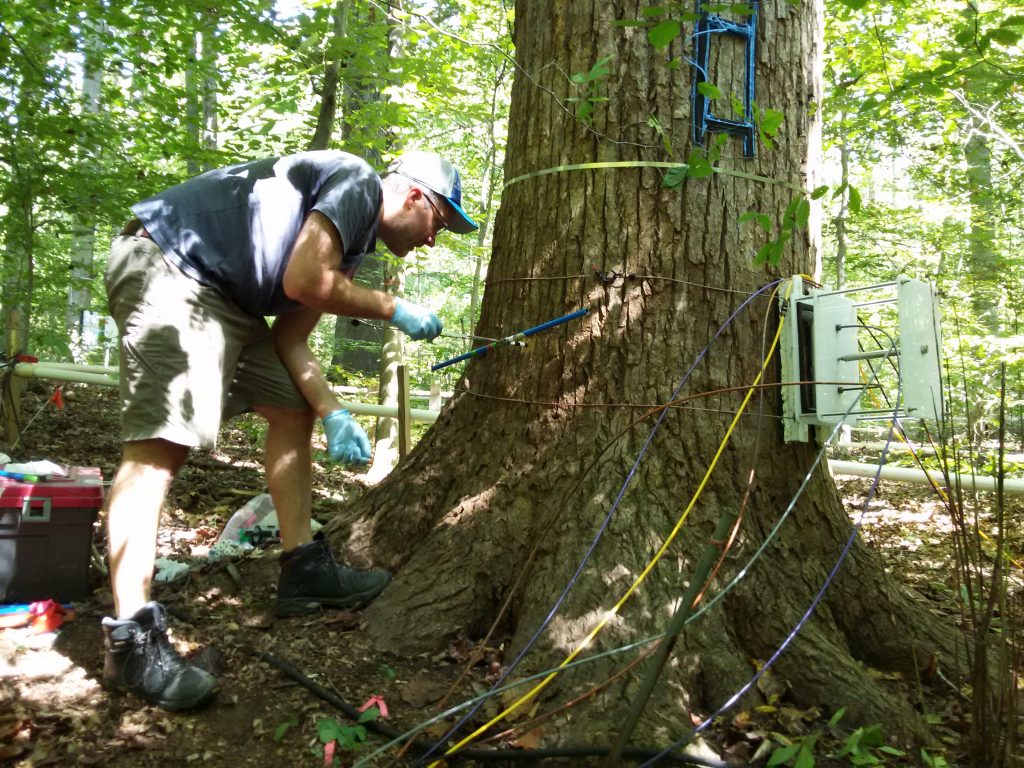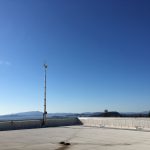
Canopy trees in upland forests emit methane from stems even though the adjacent soils consume methane. Tree stem emissions have been documented in this North American temperate deciduous forest at the Smithsonian Environmental Research Center (SERC) in Maryland, USA. Photo Credit: Paul Brewer
Until recently it was assumed that all exchange of methane between forests and the atmosphere takes place at the soil surface, and can be captured by an understory eddy covariance (EC) system. Based on a comprehensive review just published in New Phytologist, it is now clear that all surfaces in a forest—living wood, dead wood, leaves, branches, and epiphytes—can exchange methane, a fact that will change our approach to attributing sources and sinks in forest methane budgets. Tree methane emissions can dramatically increase the source strength of wetland forests, modestly decrease the sink strength of upland forests, and cause some forests to switch between acting as a net sink and net source of this powerful greenhouse gas.

Figure 1. The variety of CH4 sources and sinks in upland and wetland forests. Red arrows are CH4 sources and blue arrows are sinks (From Covey & Megonigal 2019).
The authors’ reviewed journal articles and gray literature for methane in forests, trees, saplings and seedlings worldwide, covering the earliest peer-reviewed publication in 1907 to the present, and observation techniques ranging from EC to chambers to sampling internal tree gases.
The review highlights that both physical and biological processes regulate tree methane dynamics. Living and dead trees transport and emit methane produced in soils; living trees and dead wood emit methane produced by microorganisms inside trees and consume methane from the atmosphere; and trees produce methane through an abiotic photochemical process. Scaling from stem or leaf measurements to trees or forests is limited by knowledge of the mechanisms by which trees transport soil-produced and atmosphere gases, the ecology of microbial communities inside trees that produce and oxidize methane, a lack of mechanistic models, complex overlap between sources and sinks, and extreme variation across individual trees.

Smithsonian Post-Doctoral Fellow Paul Brewer uses tree gas flux chambers, wood core incubations, and other techniques to understand the mechanisms by which upland trees emit or consume methane. Photo Credit: Drew Peresta.
Forests’ layered canopies already present challenges for EC scientists measuring carbon dioxide, water, and energy fluxes. This new review shows that advancing our understanding of the complex processes that regulate methane source–sink dynamics in trees and forests also requires cross-disciplinary research and new conceptual models that transcend the traditional binary classification of wetland versus upland forest.
This post was authored by Dr. Patrick Megonigal (Smithsonian Environmental Research Center) for the AmeriFlux Year of Methane.
Covey K.R. and Megonigal J.P. 2018. Methane Production and Emissions in Trees and Forests. New Phytologist. doi: 10.1111/nph.15624




No Comments
Be the first to start a conversation